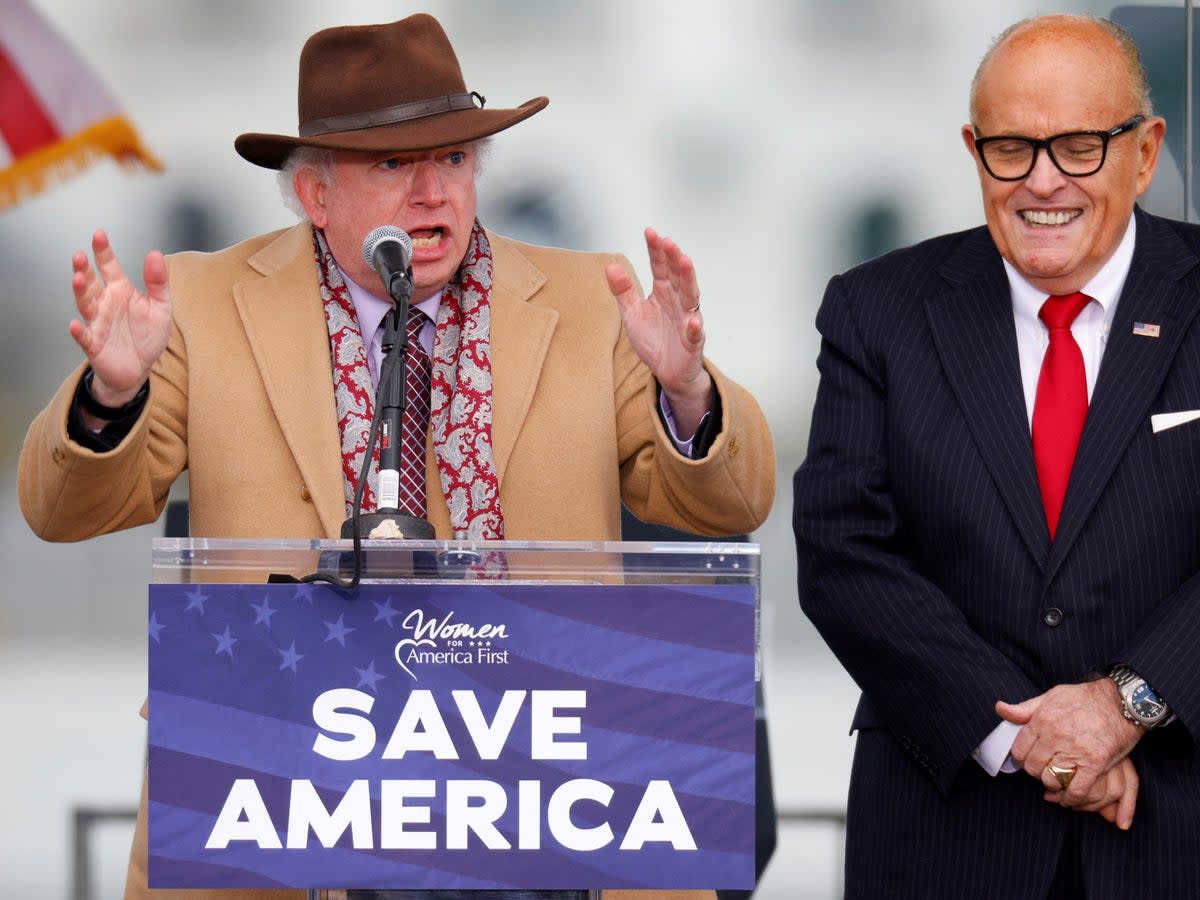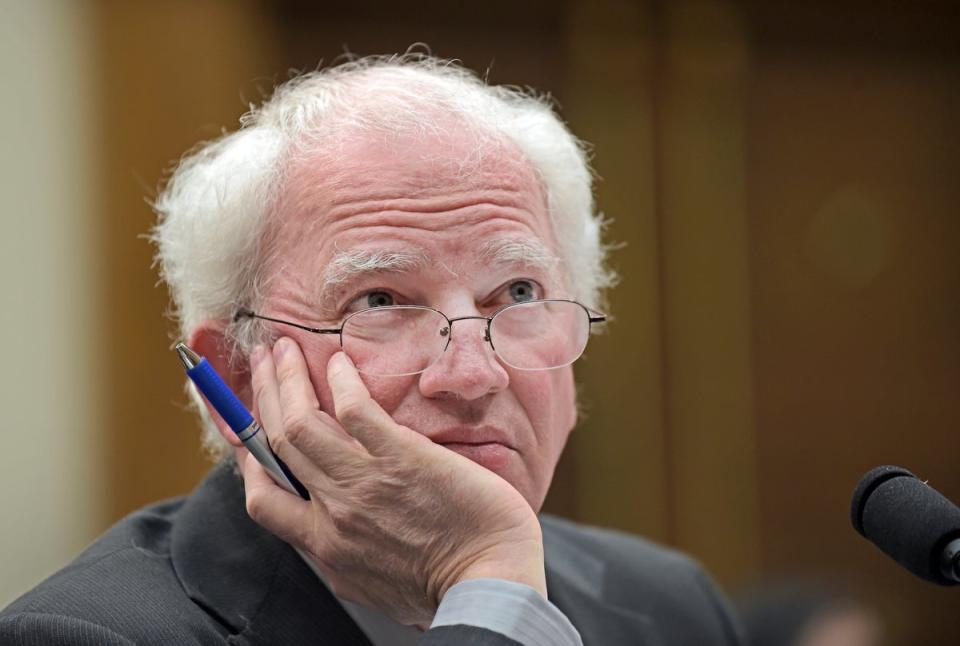Who is ‘Coup Memo’ author John Eastman and what role did he play in pushing Trump’s plan to derail democracy?

- Oops!Something went wrong.Please try again later.
- Oops!Something went wrong.Please try again later.
- Oops!Something went wrong.Please try again later.
- Oops!Something went wrong.Please try again later.
- Oops!Something went wrong.Please try again later.
When John Eastman took to the stage at the “Stop the Steal Rally” on the morning of Jan 6 2021 – dressed in a camel coat, wearing a fedora, and standing next to Rudy Giuliani – many in the crowd may not have known who he was.
Pretty soon, however, they got to hear what Eastman thought about the recently-fought 2020 presidential election, and how the supporters of Donald Trump, and those very close to him, might go about turning things around.
The election, he said falsely, had suffered from “fraud”, and officials had “ignored or violated state law”.
“We know that dead people voted,” he went on.
Eastman, then a professor of law at the small Chapman University in Orange County, California, had an easy fix to suggest to the crowd. In essence, he wanted vice president Mike Pence, about to oversee a Joint Session of Congress to certify the electoral college votes of Joe Biden, to press the pause button.
“And all we are demanding of Vice President Pence is this afternoon at 1pm, he let the legislators of the state look into this so we get to the bottom of it, and the American people know whether we have control of the direction of our government, or not,” he said.
Soon, Trump himself was up on stage, about to tell his supporters to “fight like hell”, comments that would presage their marching on the Capitol, some of them chanting “Hang Mike Pence”, and hundreds storming the building.
“John is one of the most brilliant lawyers in the country,” claimed Trump.
“And he looked at this and he said what an absolute disgrace that this can be happening to our constitution.”
The appearance at the rally of Eastman may mark the most obvious visual evidence as to how a little-known figure on the fringes of the conservative moment had made his way inside the corridors of power in the dark, gasping-for-air days of the Trump administration, and inside the mind of a defiant, desperate and dishonest president.
This week, United States House Select Committee on the January 6 Attack, has been hearing lots about Eastman and his opinions, and how he and Trump had tried to persuade Pence on Jan 5, in an Oval Office meeting, that he had the constitutional power to block Biden’s ascent.
His theory, as he outlined in a series of memos – later described by some critics as the “Coup Memos” and based on his alternative reading of the 12 Amendment of the Constitution – suggested the Vice President was the ultimate arbiter in cases where there was disagreement over results, and could oversee the appointment of alternative pro-Trump electors from states where Biden had won. (These documents were later described by some critics as a “coup memo”.)
Working out of a room at the Willard Hotel in Washington DC, Eastman and others convinced Trump and some of those close to him, that even at this late, late stage he could retain the presidency.
The courts had already rejected scores of legal challenges, made by the likes of his legal advisors Giuliani or Sidney Powell.
And one crucial person also rejected Eastman’s theory on the extent of the vice presidential powers – Pence himself.
“It is my considered judgment that my oath to support and defend the Constitution constrains me from claiming unilateral authority to determine which electoral votes should be counted and which should not,” Pence said in a letter to Congress on Jan 6.
Someone more outspoken on this topic was White House lawyer Eric Herschmann. This week, the committee heard that Herschmann had spoken to Eastman on Jan 7, when he had called the White House to ask about the potential to make another legal challenge.
“I don't remember why he called me,“ Herschmann said. “He started asking me something about dealing with Georgia and preserving something potentially for appeal.”
He added: “I said to him, 'are you out of your f***ing mind?' right. I said, ”I only want to hear two words coming out of your mouth from now on — orderly transition.”

Eastman has not been accused of any crime or faced any charge.
However it may be that Eastman himself knew that his theories were beyond the scope envelope not just of normal precedent, but also outside the usual understanding of the law.
“Did John Eastman ever admit in front of the president that his proposal would violate the Electoral Count Act?” investigators asked Greg Jacob, Pence’s former legal counsel, in a video testimony released on Thursday.
Jacob replied: “I believe he did on the fourth.”
Jacob also revealed he had sent an email to Eastman on January 6, saying that “thanks to your bulls**t, we are now under siege”.
Eastman replied by saying, “the siege is because you and your boss [the VP] did not do what was necessary”, Jacob said.
On Thursday, the committee heard that Eastman had asked for a presidential pardon from Trump.
Democratic Congressman Pete Aguilar said that Trump’s then-attorney Rudy Giuliani, “requested that he be included on a list of potential recipients of a presidential pardon”.
Aguilar then read from Eastman’s email, in which he said: “I’ve decided that I should be on the pardon list, if that is still in the works.”
Also this week, it was revealed that the committee possessed emails between Eastman and Ginni Thomas, a conservative activist and wife of Supreme Court Justice Clarence Thomas. Eastman once clerked for Thomas, and his wife was in contact with a number of people in or around the White House at the time of the 2020 election, offering support to Trump’s efforts to hold on to power.
This week, it was separately reported that Eastman claimed in an email after Election Day 2020 to have insight into a “heated fight” among the Supreme Court justices over whether to hear arguments about the president’s efforts to overturn his defeat at the polls.
Jacob sent an email to Eastman on January 6 saying that "thanks to your bullshit, we are now under siege." Eastman replied by saying, "the siege is because you and your boss [the VP] did not do what was necessary." pic.twitter.com/lBE5HivVyz
— Aaron Rupar (@atrupar) June 16, 2022
The New York Times said two people familiar with the emails told the outlet that Eastman, in an email to pro-Trump lawyer Kenneth Chesebro, described the discussions as “heated”, as the White House pondered another legal challenge.
“So the odds are not based on the legal merits but an assessment of the justices’ spines, and I understand that there is a heated fight underway,” Eastman wrote.
Eastman, 62, was born in Lincoln, Nebraska, and holds a bachelor’s degree in politics and economics from the University of Dallas, a law degree from the University of Chicago Law School. It is understood that he came into Trump’s world late in the effort to retain power.
That year he had made public an opinion piece he wrote questioning whether Vice President Kamala Harris, the child of two immigrants to the United States, met the presidential qualifications.
The weekend after the Nov 3 2020, election, Eastman was invited by people in Trump’s circle to draft a legal brief that challenged the election results in Pennsylvania, one of countless failed efforts.
Eastman is no longer a law professor.
Rather, after the chaos of Jan 6 when hundreds of Trump supporters stormed the Capitol, he established the conservative Center for Constitutional Jurisprudence, a public interest law firm.
In the aftermath of the riots there were calls for him to be ousted from the university where he taught and he promptly stood down.
Uuniversity President Daniele Struppa said in a statement to the school community: “Dr Eastman’s departure closes this challenging chapter for Chapman and provides the most immediate and certain path forward for both the Chapman community and Dr Eastman.”

